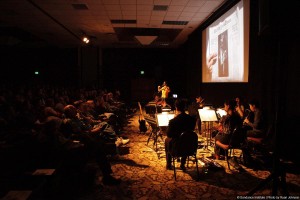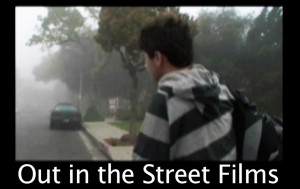by Andrew Einspruch
Filmmaker Andrew Einspruch attended Screen Forever 2013, the conference of Screen Producers Australia, this past year and wrote a series of articles for the event, which he’s kindly allowing us to reprint here. These articles originally appeared in Screen Hub, the daily online newspaper for Australian film and television professionals.
With VOD, catch-up viewing, second screens, time-shifting, cord cutting and all manner of changes looming over the content consumption landscape, it makes sense to ask, as a session did at Screen Forever 2013, “Sorry, Where Has My Audience Gone?” Andrew Einspruch tells us that the answer might surprise.
Let`s cut to the chase. Australian audiences are still couch potatoes. According to statistics shown by Dough Peiffer, CEO of OzTam, the TV audience measurement company, in 2008, the average time viewed (ATV) in the five main cities was 3:08. That`s three hours and eight minutes per person per day watching broadcast TV.
Flash forward to 2013, and the number is smaller, but not a lot — 3:03. So even with all the new technologies, devices and competing media, the amount of time Aussies sit in front of the box has been pretty steady.
Not what you might have guessed. If the question is “where`s the audience gone”, the answer, at one level, is “nowhere”.
Total use of the TV set has actually gone up, even if what is being done with it is in the throes of shifting. Live viewing declined from 2010-11 to 2012-13 from 12.5% to 11.7%. In the same period, playback went from 0.7% to 1.0%. The biggest change is everything else, the “Other Screen Usage” category, which went from 2.9% to 3.8%. This is all the other things people do with their sets, like playing with the XBox, watching a DVD, or streaming from the Apple TV.
So changes are happening, just not at a cataclysmic rate (yet). Take time-shifted viewing as an example, where people watch a show within seven days of the live broadcast. The most time shifted program in 2013 was the final ofPacked to the Rafters, which saw an extra 257,000 people watch the show after the original broadcast, an increase of just under 20%.


 There is a lot of talk in independent film circles about the need to “eventize” the cinematic experience. The thought is that audiences are increasingly satisfied with viewing films and other video material on their private devices whenever their schedule permits and the need to leave the house to go to a separate place to watch is becoming an outdated notion, especially for younger audiences. But making your work an event that can only be experienced in a live setting is something few creators are exploring at the moment. Sure, some filmmakers and distributors are adding live Q&As with the director or cast, sometimes in person and sometimes via Skype; discussion panels with local organizations are often included with documentary screenings; and sometimes live musical performances are included featuring the musicians on the film’s soundtrack, but what about work that can ONLY be enjoyed as a live experience? Work that will never appear on DVD or digital outlets? Not only is there an artistic reason for creating such work, but there can be a business reason as well.
There is a lot of talk in independent film circles about the need to “eventize” the cinematic experience. The thought is that audiences are increasingly satisfied with viewing films and other video material on their private devices whenever their schedule permits and the need to leave the house to go to a separate place to watch is becoming an outdated notion, especially for younger audiences. But making your work an event that can only be experienced in a live setting is something few creators are exploring at the moment. Sure, some filmmakers and distributors are adding live Q&As with the director or cast, sometimes in person and sometimes via Skype; discussion panels with local organizations are often included with documentary screenings; and sometimes live musical performances are included featuring the musicians on the film’s soundtrack, but what about work that can ONLY be enjoyed as a live experience? Work that will never appear on DVD or digital outlets? Not only is there an artistic reason for creating such work, but there can be a business reason as well. It would seem, to the eyes of Hollywood, the high form of film has become the franchise. It satisfies the two poles of conventional business wisdom: limiting risk as it promises more of the same, maximizing profit as it entices investors with that self-same prospect.[1] The Hobbit is stretched out to encompass three movies, hordes of young adult novels are on the horizon, and Bob Iger suggests Frozen
It would seem, to the eyes of Hollywood, the high form of film has become the franchise. It satisfies the two poles of conventional business wisdom: limiting risk as it promises more of the same, maximizing profit as it entices investors with that self-same prospect.[1] The Hobbit is stretched out to encompass three movies, hordes of young adult novels are on the horizon, and Bob Iger suggests Frozen  You’re an indie filmmaker. You can get by with relatively inexpensive equipment, cast and crew and make movies. I made a short a few years ago for $3K, just for camera, sound, and editing software. Then I used the same stuff to do another one for the cost of feeding the cast and crew, about $500. A few years later I made a feature doc for $3K with some new HD stuff. But you don’t need a cast or crew for docs. All you need is a camera, editing software, and great events to attend. However, if you do want a cast and crew, and you don’t happen to know film school buddies willing to work for free, you really have to pay them, and you may need locations, props, and so on. So we see budgets more likely starting at $50K to $500K for first time feature director narratives.
You’re an indie filmmaker. You can get by with relatively inexpensive equipment, cast and crew and make movies. I made a short a few years ago for $3K, just for camera, sound, and editing software. Then I used the same stuff to do another one for the cost of feeding the cast and crew, about $500. A few years later I made a feature doc for $3K with some new HD stuff. But you don’t need a cast or crew for docs. All you need is a camera, editing software, and great events to attend. However, if you do want a cast and crew, and you don’t happen to know film school buddies willing to work for free, you really have to pay them, and you may need locations, props, and so on. So we see budgets more likely starting at $50K to $500K for first time feature director narratives. 